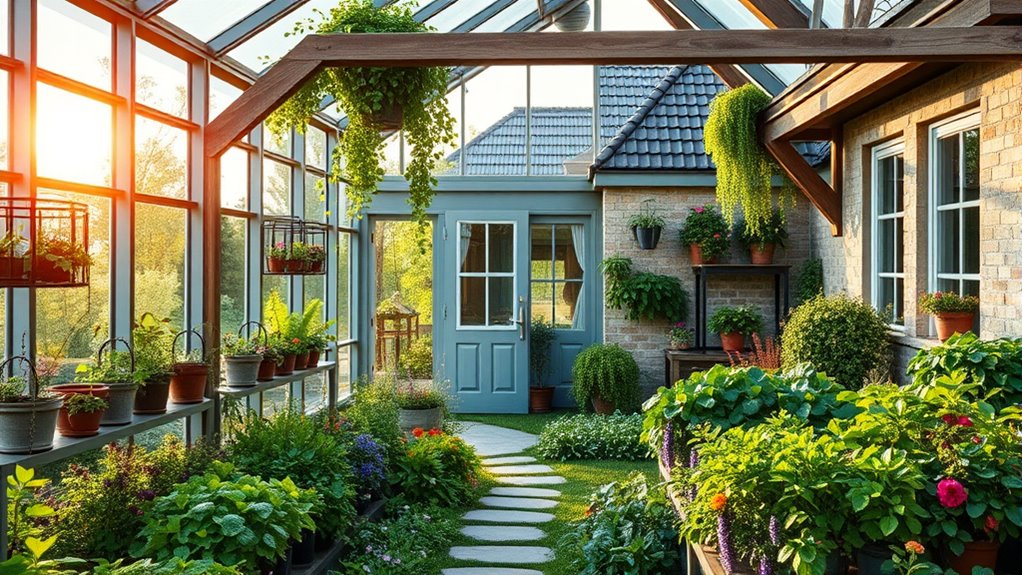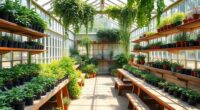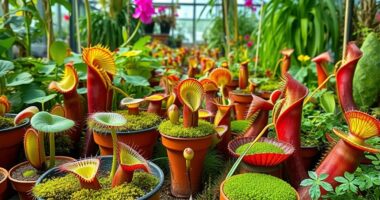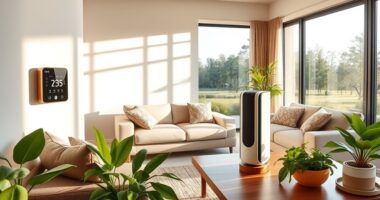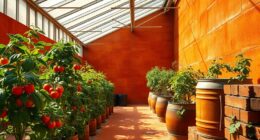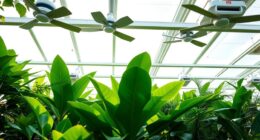If you're looking to maximize your gardening space, attached greenhouses are a fantastic choice. I've found that designs like the HOWE Polycarbonate Greenhouse and the Palram Canopia Rion Sun Room are particularly effective for extending your growing seasons. I also love the versatility of the 8×14 FT Polycarbonate Aluminum Greenhouse Kit. Each option has unique features that can elevate your gardening experience. Stick around, and I'll share more incredible designs that could fit perfectly in your backyard.
Key Takeaways
- Attached greenhouses efficiently utilize existing structures, maximizing gardening space while providing easy access to utilities and resources.
- Lean-to designs are ideal for small backyards, allowing for optimal sunlight exposure against a wall.
- Incorporating adjustable vents improves air circulation and temperature control, enhancing plant growth in attached greenhouses.
- Use sturdy materials like polycarbonate panels and aluminum frames to ensure durability and stability against adverse weather conditions.
- Plan for effective drainage and consider local climate conditions to optimize the greenhouse's performance and longevity.
The Year-Round Solar Greenhouse Guide
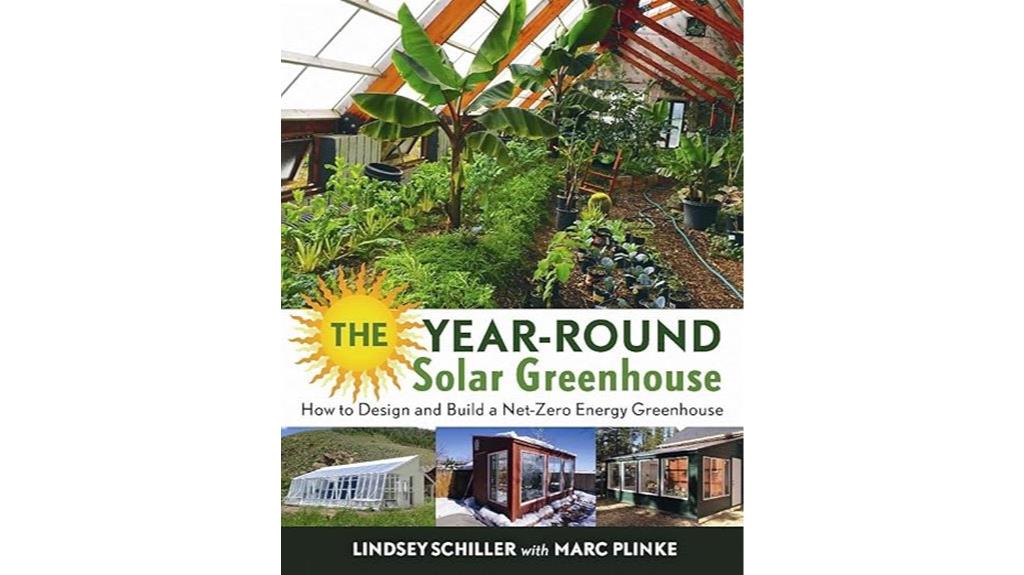
If you're a hands-on gardener enthusiastic to extend your growing season, "The Year-Round Solar Greenhouse Guide" is just what you need. This book's engaging writing style makes it easy to absorb essential information on various greenhouse building techniques. While it offers a broad overview, you'll want to have some handy skills to implement the ideas effectively. I found the GAHT system particularly fascinating; it's an innovative way to maintain warmth in winter. Plus, it includes suggestions for further reading that deepened my understanding. Overall, it's a fantastic resource for anyone wanting to build a solar greenhouse confidently.
Best For: This book is best for hands-on gardeners looking to extend their growing seasons through innovative greenhouse construction techniques.
Pros:
- Engaging writing style that makes complex information easy to understand.
- Comprehensive coverage of various greenhouse building techniques, making it a valuable resource.
- Innovative features like the GAHT system, which provides effective year-round functionality.
Cons:
- Some readers may find a lack of detailed guidance on specific construction techniques.
- It may be more suited for those who are handy and capable of extrapolating information for practical application.
- Beginners might need to supplement their learning with additional resources for in-depth understanding.
How to Build Your Own Greenhouse: Designs and Plans
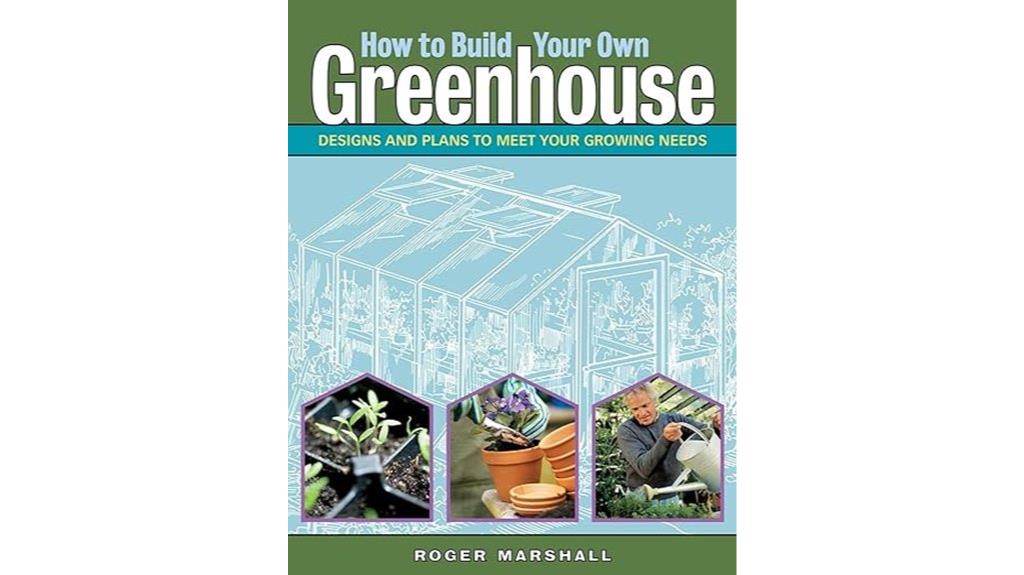
For those enthusiastic to enhance their gardening experience, "Attached Greenhouse Designs" offers practical solutions tailored to individual needs and spaces. I found a thorough guide to greenhouse construction invaluable, covering materials and designs for various climates. It's accessible, with clear pictures and drawings that simplify communication with contractors. While it's great for general projects, it doesn't dive deep into specialized topics like aquaponics. Compared to cheaper alternatives, this resource stands out for its detail. I highly recommend it for DIY builders aiming for professional results, though it might feel overwhelming for those just wanting basic structures. Happy building!
Best For: DIY greenhouse builders aiming for professional-quality results while seeking a comprehensive guide to construction.
Pros:
- Comprehensive resource covering various materials and designs suited for different climates and plant types.
- Accessible and user-friendly, with clear pictures and drawings that facilitate communication with contractors.
- More informative than cheaper alternatives, providing in-depth insights for effective planning and construction.
Cons:
- Limited information on specialized topics like aquaponics, which may require additional research.
- Can be overwhelming for those only interested in basic greenhouse structures.
- May not cater to advanced builders looking for highly specialized designs or techniques.
HOWE Polycarbonate Greenhouse with Double Swing Doors
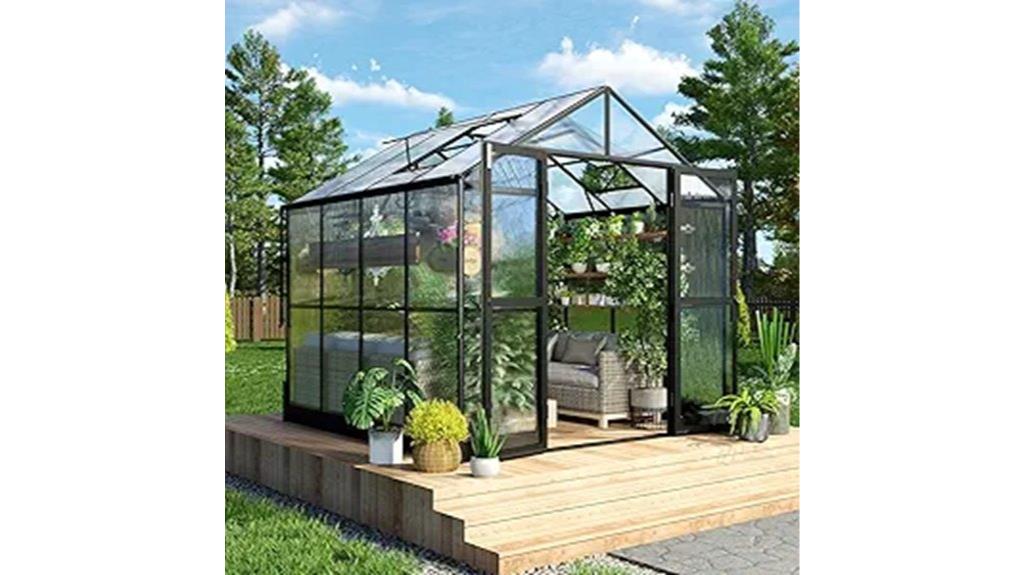
The HOWE Polycarbonate Greenhouse with Double Swing Doors is an excellent choice for gardening enthusiasts who value durability and functionality. Measuring 8x8x7.5 feet, its 6mm twin-wall panels offer exceptional UV protection. I love the double swing doors and adjustable roof vents, which provide excellent ventilation. Its rust-resistant aluminum frame withstands strong winds and heavy snow loads, ensuring stability during storms. Although installation can be challenging, the results are worth it. I appreciate the built-in drainage system for efficient water management and how it retains heat, creating a perfect environment for my plants. It's truly a reliable addition to my gardening space!
Best For: Gardening enthusiasts seeking a durable and functional greenhouse that provides excellent ventilation and weather resistance.
Pros:
- Durable Construction: Made with 6mm twin-wall polycarbonate panels and a rust-resistant aluminum frame, ensuring longevity and stability.
- Excellent Ventilation: Features double swing doors and adjustable roof vents for optimal air circulation.
- Heat Retention: Effectively retains heat, creating an ideal growing environment for plants during colder weather.
Cons:
- Challenging Installation: Assembly can take 20-30 hours and may require multiple people, with difficult instructions noted by users.
- Additional Support Needed: Some users experienced the need for extra assistance from the company during installation, which can delay the process.
- Maintenance Required: Regular cleaning is necessary to prevent dirt build-up, which can be time-consuming.
Black & Decker Complete Guide to DIY Greenhouses, 2nd Edition
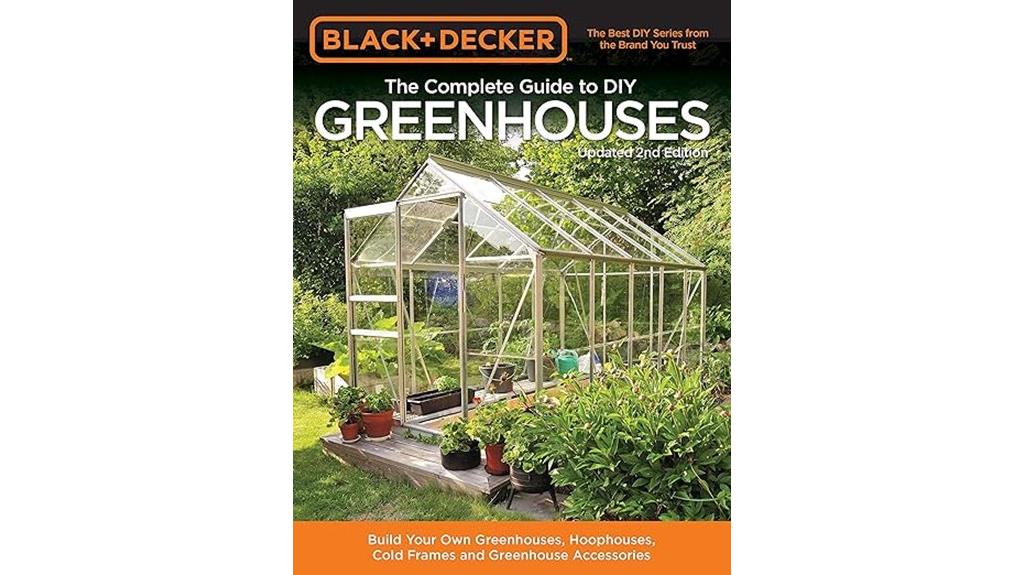
DIY enthusiasts looking to create their own greenhouses will find "Black & Decker Complete Guide to DIY Greenhouses, 2nd Edition" an invaluable resource. This thorough guide covers everything from hoophouses to cold frames, offering clear construction techniques and essential components like ventilation and insulation. I appreciate the extensive color photography and detailed plans, which make it easy for both beginners and experienced gardeners. While some measurements may require adjustments, the book's layout is user-friendly. It even touches on other garden structures, making it a versatile tool for enhancing your gardening capabilities. Trust me, this guide is worth having!
Best For: DIY enthusiasts and gardeners seeking comprehensive guidance on building and maintaining greenhouses of various types.
Pros:
- Extensive color photography and detailed construction plans make it accessible for all skill levels.
- Covers a wide range of greenhouse structures, providing flexibility for different gardening needs.
- User-friendly layout and additional information on garden structures enhance overall gardening capabilities.
Cons:
- Some measurements may be inaccurate, requiring adjustments during construction.
- Beginners might find certain construction techniques challenging without prior experience.
- Limited focus on advanced greenhouse technologies or automation systems.
Palram Canopia Rion Sun Room Solarium Greenhouse DIY Kit
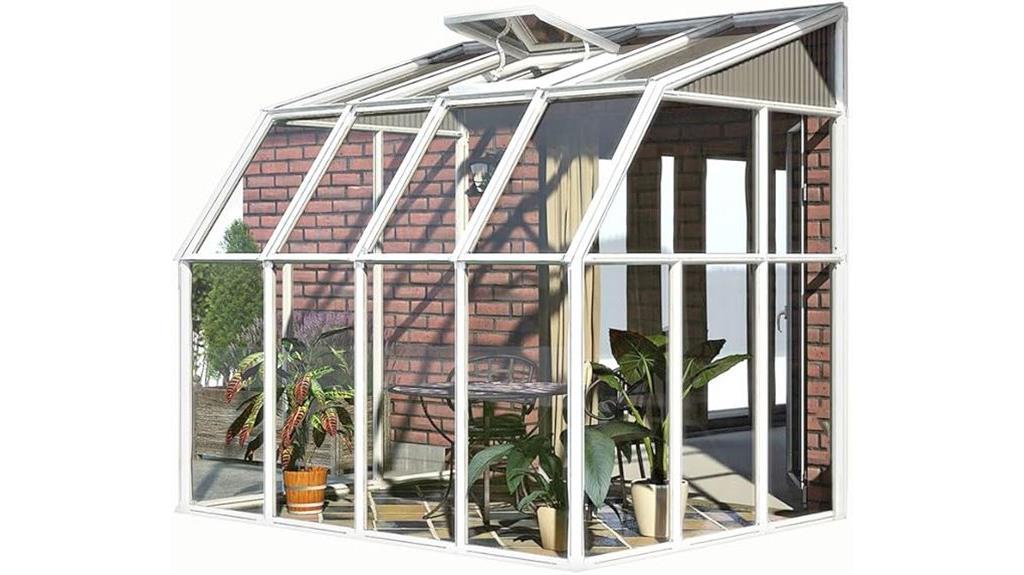
If you're looking to create a charming space for your plants while enjoying a bit of sunshine, the Palram Canopia Rion Sun Room Solarium Greenhouse DIY Kit might just be your ideal choice. This 6 ft. x 8 ft. lean-to greenhouse features durable, maintenance-free resin framing and UV-protected twin-wall polycarbonate panels. While assembly can take 2-8 hours and may require patience, many users love the final result. However, some have faced challenges with parts fitting and roof leaks. Overall, it's a solid option for DIY enthusiasts, but consider your climate to avoid potential durability issues.
Best For: DIY enthusiasts looking to create a charming greenhouse space for their plants in moderate climates.
Pros:
- Durable, maintenance-free resin frame and UV-protected panels ensure longevity.
- Provides excellent air circulation with a hinged door and roof vent.
- Users often express satisfaction with the final aesthetic and functionality for growing various plants.
Cons:
- Assembly can be challenging, with reports of parts not fitting together easily.
- Some users have experienced roof leaks and frame sagging over time.
- Durability issues may arise in areas with heavy snow or extreme weather conditions.
GREENHOUSE GARDENING FOR BEGINNERS: Complete Guide to Growing Vegetables and Fruits
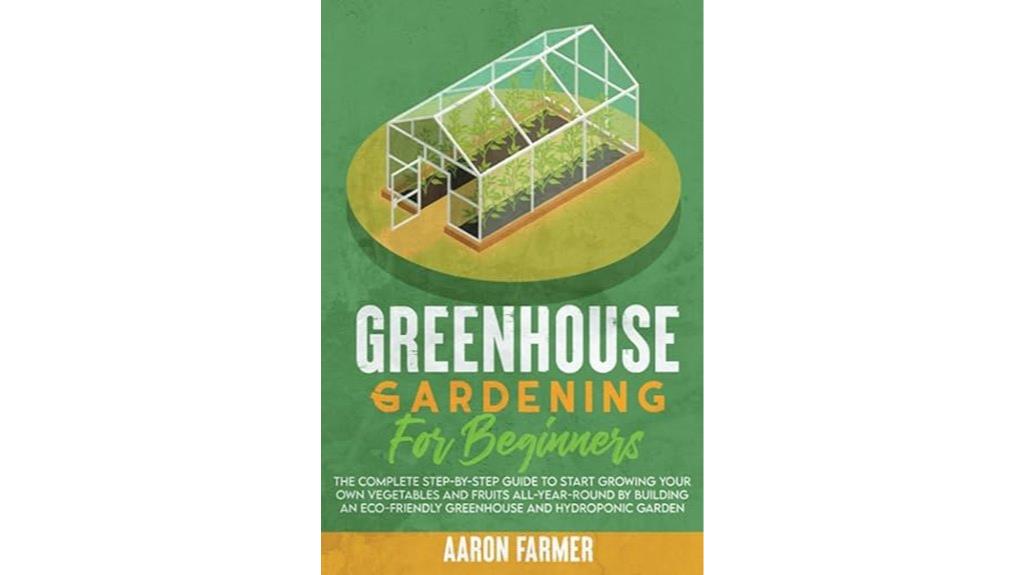
For beginners enthusiastic to immerse themselves in greenhouse gardening, "Attached Greenhouse Designs" offers a practical and straightforward approach to growing vegetables and fruits. This guide simplifies complex concepts, making it easy for those without prior experience. It covers everything from selecting the right greenhouse to maintaining it, ensuring you can extend your growing season. I found valuable crop guides for popular vegetables and fruits, along with practical tips to avoid common mistakes. While some may seek more depth, this resource provides a solid foundation. Just keep your expectations in check, and you'll be well on your way to successful greenhouse gardening!
Best For: Beginners in greenhouse gardening looking for an accessible and straightforward guide to growing vegetables and fruits.
Pros:
- Easy to understand: Simplifies complex concepts for those without prior experience.
- Comprehensive coverage: Includes essential topics like greenhouse selection, maintenance, and crop guides.
- Practical tips: Offers valuable advice on avoiding common mistakes and saving money.
Cons:
- Lacks depth: Some readers may find the information too basic for their needs.
- Quality issues: Contains poorly proofread sections and nonsensical statements.
- Mixed applicability: While useful for beginners, it may not meet the demands of more experienced or commercial gardeners.
VEIKOU 6 x 10 Greenhouse with Adjustable Vent
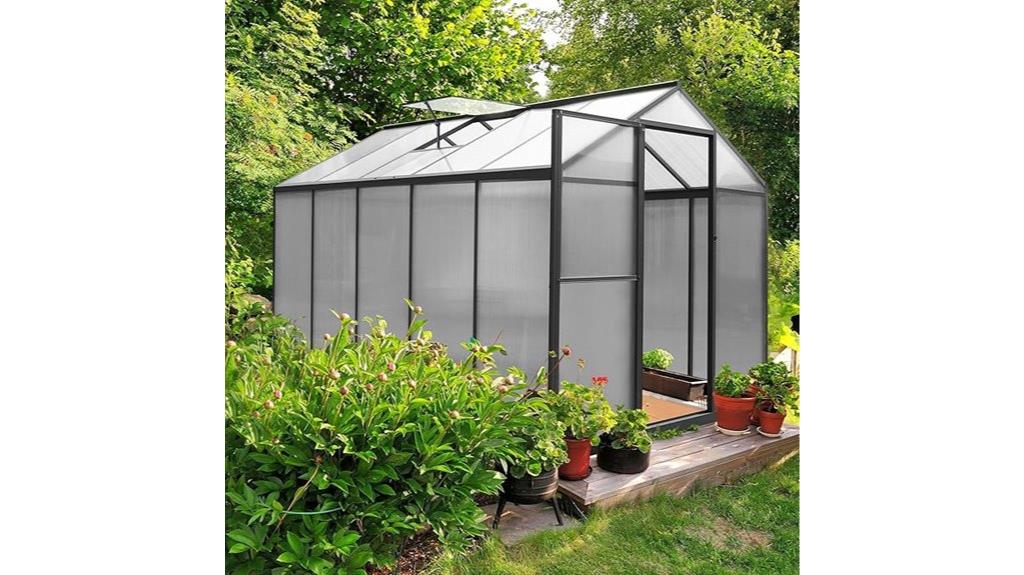
The VEIKOU 6 x 10 Greenhouse, featuring an adjustable vent, is perfect for gardeners looking to create an ideal environment for their plants. With its sturdy aluminum frame and 4mm thickened twin-wall polycarbonate, it offers excellent heat preservation and light transmittance. I appreciate the adjustable vent, allowing for optimal air circulation tailored to my plants' needs. Installation was straightforward, thanks to the clear instructions, although I recommend securing it with a solid base and silicone for durability. Overall, it's a solid choice for maximizing gardening space, though be prepared for some additional costs to enhance its stability.
Best For: Gardeners seeking a durable and efficient greenhouse solution that allows for optimal plant care and air circulation.
Pros:
- Sturdy aluminum frame designed for long-lasting durability and resistance to rust and dirt.
- 4mm thickened twin-wall polycarbonate provides excellent heat preservation and light transmittance, suitable for various climates.
- Adjustable vent allows for customizable air circulation, enhancing the growing environment for plants.
Cons:
- Some users reported missing parts and assembly issues, which could complicate the installation process.
- Additional costs for base construction and sealing may be necessary to enhance stability and weather resistance.
- Mixed customer feedback suggests that it may require significant effort to secure against adverse weather conditions.
Strong Camel Walk-in Greenhouse with 3 Tiers and 6 Shelves
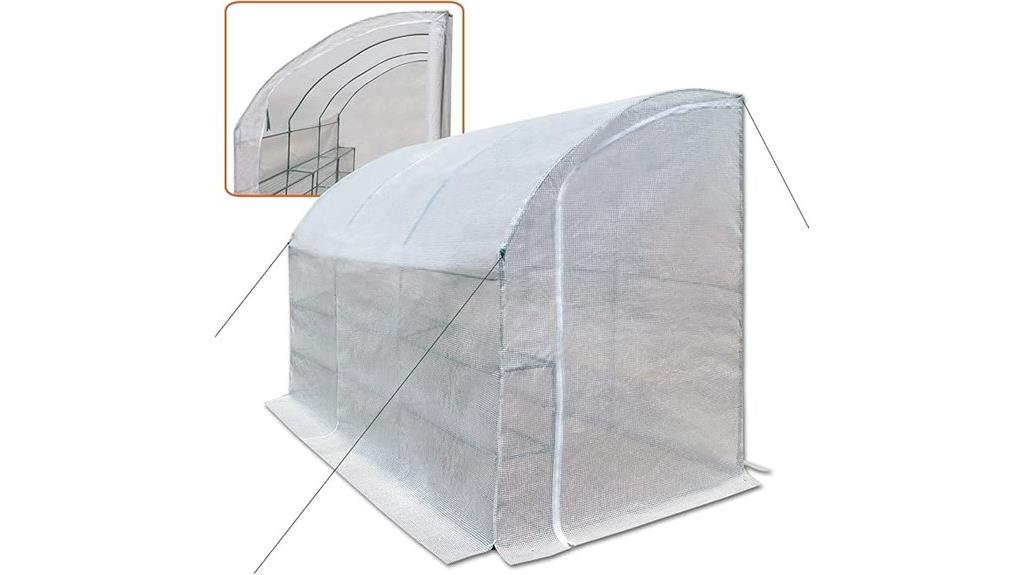
Looking for an affordable way to extend your gardening season? The Strong Camel Walk-in Greenhouse might just be what you need. Measuring 10ft x 5ft x 7ft, it features three tiers and six shelves, perfect for organizing plants. Its water-resistant, UV-protected cover traps heat, helping seedlings thrive while protecting them from pests. I appreciate the roll-up zippered door for easy access and ventilation. Installation can be a bit tricky, but using zip ties or bricks can help secure it. While it's budget-friendly, keep in mind that it may struggle in high winds or with heavy plants. Happy gardening!
Best For: Budget-conscious gardeners looking to extend their growing season and organize their plants in a compact space.
Pros:
- Easy access and ventilation through the roll-up zippered door.
- Water-resistant and UV-protected cover helps trap heat for optimal plant growth.
- Compact design with three tiers and six shelves maximizes space for growing plants.
Cons:
- Potential durability issues in high winds and with heavy plants.
- Assembly can be challenging for some users, requiring additional securing methods.
- Mixed customer feedback regarding long-term stability and customer service experiences.
Palram – Canopia 4×8 Lean-To Greenhouse for Outdoors
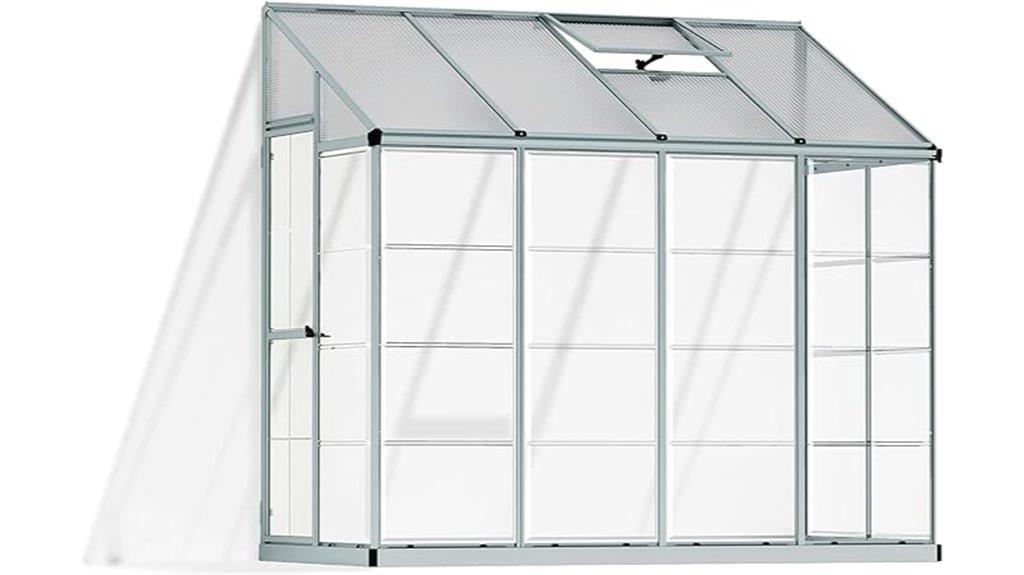
If you're searching for a compact greenhouse that maximizes your growing potential, the Palram – Canopia 4×8 Lean-To Greenhouse is an excellent choice for small backyards and patios. Its UV polycarbonate panels block 99.9% of harmful rays while allowing over 90% light transmission, ensuring your plants thrive. The durable aluminum frame is rust-resistant, designed to withstand winds up to 47 mph. Assembly might take a few days, but with two people, it's manageable. I appreciate the adjustable roof vent for airflow and the lockable door for security. This greenhouse truly extends my growing season while keeping my plants safe.
Best For: Gardeners with limited space looking to extend their growing season and protect their plants from harsh weather conditions.
Pros:
- Durable construction: Rust-resistant aluminum frame and UV-blocking polycarbonate panels ensure longevity and plant safety.
- Excellent light transmission: Allows over 90% light to reach plants while blocking harmful UV rays.
- Adjustable roof vent: Provides necessary airflow to maintain a healthy growing environment.
Cons:
- Assembly challenges: Some users find the installation instructions difficult to follow, requiring adjustments during setup.
- Potential panel dislodgement: High winds may cause panels to dislodge unless additional securing measures are taken.
- Requires two people for assembly: Installation is more manageable with help, which may be inconvenient for solo users.
Machrus OGrow Small Greenhouse for Outdoors
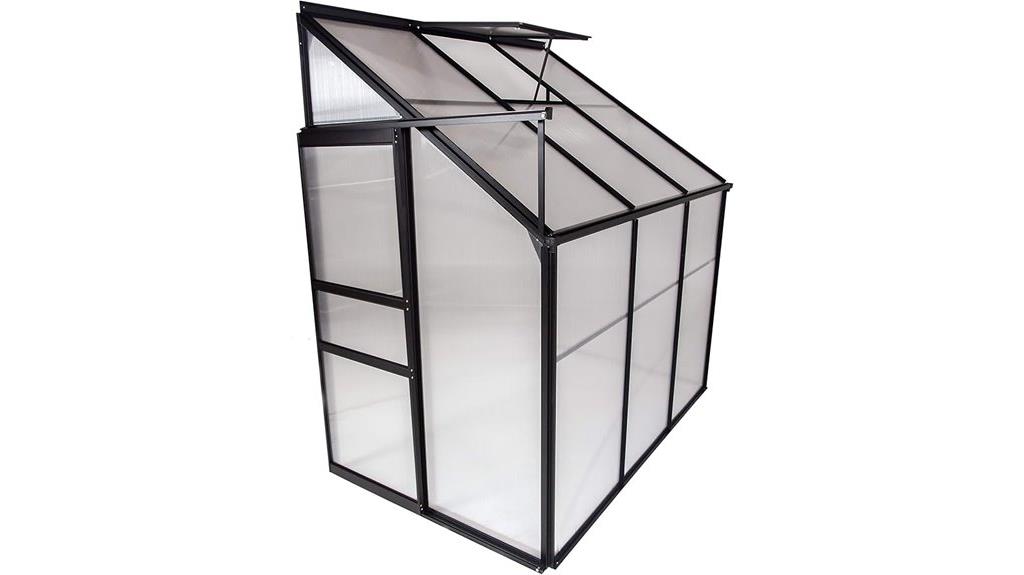
For gardeners seeking a compact yet efficient solution to extend their growing season, the Machrus OGrow Small Greenhouse offers a perfect blend of functionality and style. With its heavy-duty aluminum frame and polycarbonate panels, this greenhouse blocks 99% of UV rays, ensuring ideal plant growth. Measuring 75.6 inches deep and 49.2 inches wide, it fits well in any outdoor space. Though assembly can be tricky, especially without extra hands, the integrated features like adjustable roof vents and a sliding door enhance usability. While customer reviews vary, I appreciate its aesthetic charm and effective ventilation for my garden needs.
Best For: Gardeners looking for a compact greenhouse solution that enhances plant growth while adding aesthetic value to their outdoor space.
Pros:
- Lightweight design makes it easy to move and reposition as needed.
- Blocks 99% of UV rays, promoting healthy plant growth with effective ventilation.
- Stylish shabby chic appearance complements various outdoor settings.
Cons:
- Assembly can be complex and may require multiple people for support.
- Some users report flimsy materials and structural issues post-assembly.
- Customer support and return process have received negative feedback from users.
Palram – Canopia 12×10 Garden Solarium Greenhouse
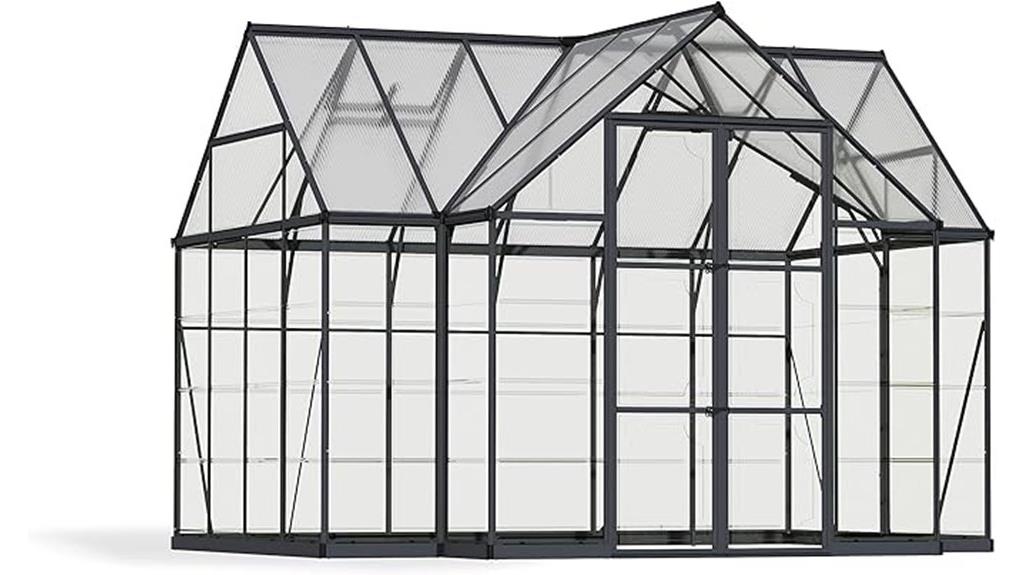
The Palram – Canopia 12×10 Garden Solarium Greenhouse is perfect for the passionate gardener seeking a spacious and functional environment for plant growth. With 95 square feet of growing space, its 4mm twin-wall roof panels block 99.9% of UV rays while allowing 90% light transmission. I love the reinforced aluminum frame, which stands strong against the elements, especially when properly anchored. Although assembly can be tricky and may take around three days, the beautiful design makes it worth it. Just keep an eye out for potential modifications to enhance durability and prevent gaps for vermin.
Best For: The Palram – Canopia 12×10 Garden Solarium Greenhouse is best for passionate gardeners looking for a spacious and functional environment to grow their plants.
Pros:
- Beautiful design that enhances garden aesthetics.
- Solid construction once assembled, capable of withstanding high winds.
- Ample growing space with excellent light transmission and UV protection.
Cons:
- Assembly can be challenging and time-consuming, with reports of missing parts.
- Some materials, such as doors and brackets, may feel flimsy and bend under stress.
- Potential gaps that allow vermin and water entry, requiring modifications for optimal use.
4x2ft Lean-to Polycarbonate Greenhouse
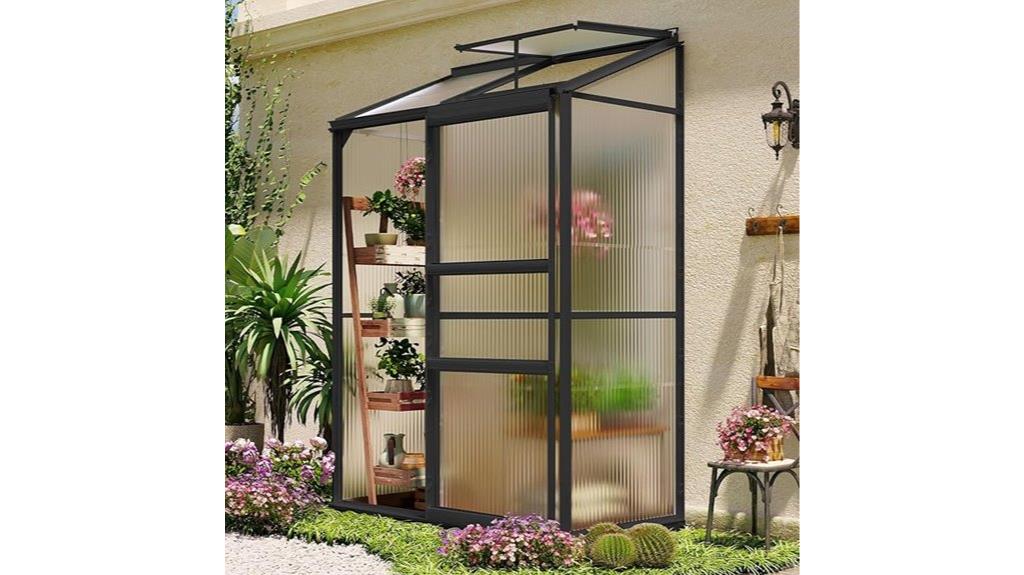
Looking for a compact greenhouse that maximizes space while offering durability and functionality? The 4x2ft Lean-to Polycarbonate Greenhouse is perfect for both novice and seasoned gardeners. Its shatterproof, twin-wall polycarbonate panels protect your plants from harmful UV rays while balancing light and temperature. With a sturdy aluminum frame and reinforced steel base, it withstands strong winds and snow loads. It features ventilation windows and a sliding door for easy access. While assembly can be tricky, the effort pays off with a reliable space for growing vegetables, flowers, or even turning it into a cozy living area.
Best For: Those looking for a compact, durable greenhouse to enhance their gardening experience, whether they are beginners or experienced gardeners.
Pros:
- Sturdy construction with shatterproof polycarbonate panels that block UV rays and maintain a stable environment for plants.
- Features ventilation windows and a sliding door for easy access and airflow.
- Versatile design suitable for growing a variety of plants or transforming into a small living space.
Cons:
- Assembly can be challenging, with some users reporting misaligned parts and unclear instructions.
- Requires a solid foundation; not suitable for placement directly on dirt or grass.
- Mixed reviews on material quality, with some concerns about panel misalignment and cutting requirements.
6×12 FT Greenhouse Kit for Outdoor
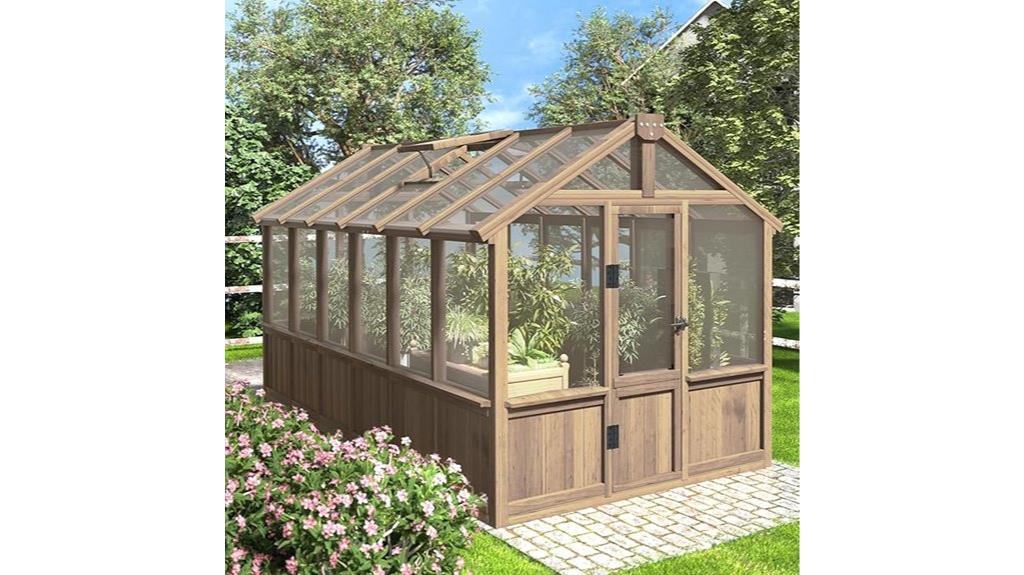
If you're after a spacious and sturdy greenhouse that can withstand various weather conditions, the Yardenaler 6×12 FT Greenhouse Kit is an excellent choice. Its fir wood frame and 6MM thick polycarbonate panels guarantee durability while promoting high light transmission. I love the adjustable roof that opens up to 45 degrees, enhancing airflow and maintaining ideal temperatures for my plants. Plus, the lockable door adds a layer of security. Measuring 74 W x 143.4 L x 83.5 H, it offers ample space for my flowers and veggies, making it a versatile addition to my gardening setup.
Best For: Gardening enthusiasts looking for a durable and spacious greenhouse to cultivate flowers, vegetables, and plants in various weather conditions.
Pros:
- Sturdy Construction: Made from fir wood and 6MM thick polycarbonate, ensuring durability and high light transmission.
- Adjustable Roof Vent: Allows for improved air circulation and temperature balance, enhancing plant growth conditions.
- Versatile Use: Provides ample space for gardening activities and can also be used for equipment storage or as a relaxation area.
Cons:
- Heavy Weight: The greenhouse weighs 317 pounds, which may make installation challenging without assistance.
- Roof Vent Design Concerns: Some customers have noted issues with the roof vent design, which could affect ventilation efficiency.
- Shipping Delays: Product ships in five boxes that may not arrive simultaneously, potentially delaying setup.
8×14 FT Polycarbonate Aluminum Greenhouse Kit
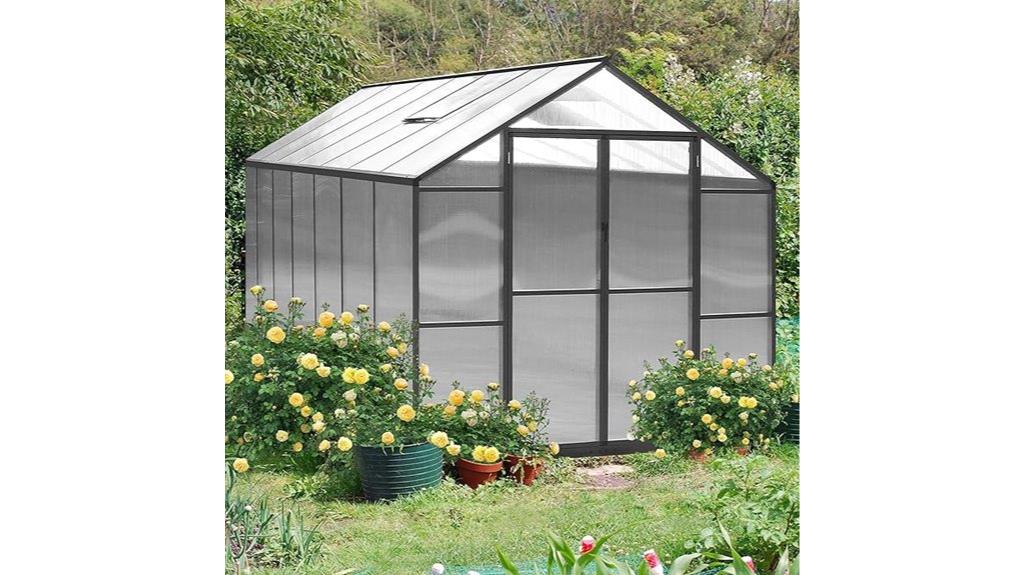
For anyone seeking a reliable and spacious gardening solution, the 8×14 FT Polycarbonate Aluminum Greenhouse Kit stands out with its robust aluminum frame and thick polycarbonate panels. I love how the gray powder-coated aluminum is not only rust-resistant but also stable in any climate. With two adjustable roof vents, I can easily control ventilation, and the swing-out lockable door guarantees security. This greenhouse provides ample space for growing flowers, vegetables, and even storing garden tools. Plus, the upgraded structure makes assembly a breeze. If you're serious about gardening, this kit is a fantastic investment!
Best For: This greenhouse kit is best for gardening enthusiasts looking for a sturdy and spacious solution to grow plants year-round.
Pros:
- Robust aluminum frame is rust-resistant and stable in all climates.
- Thick polycarbonate panels enhance warmth and sunlight absorption for optimal plant growth.
- Easy assembly process with upgraded structure and adjustable roof vents for effective ventilation.
Cons:
- Shipping may not be simultaneous as the product arrives in two boxes.
- Limited customer ratings (only one rating) may not provide a comprehensive view of user experiences.
- Size may not be suitable for those with limited outdoor space.
AMERLIFE Polycarbonate Walk-In Greenhouse
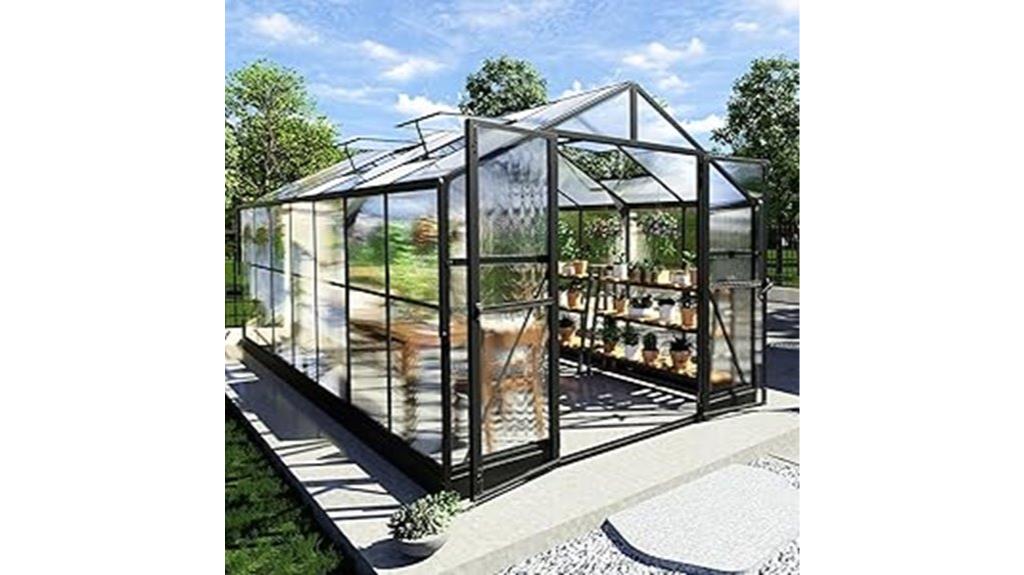
The AMERLIFE Polycarbonate Walk-In Greenhouse stands out with its generous 8x14x7-foot dimensions, making it an ideal choice for avid gardeners seeking ample space to cultivate plants year-round. I appreciate its robust design, featuring thickened corner columns and twin-wall polycarbonate panels that effectively retain heat while blocking harmful UV rays. Although assembly can be tricky—taking anywhere from 6 to 18 hours—the quick-connect joints simplify the process. With four vent windows for airflow and a built-in gutter system for drainage, this greenhouse offers versatility. Just be prepared to enhance insulation with caulking to optimize your gardening experience!
Best For: Avid gardeners looking for a spacious, all-season greenhouse to cultivate plants while enjoying a sturdy and versatile design.
Pros:
- Robust structure with thickened corner columns for enhanced stability.
- Twin-wall polycarbonate panels effectively retain heat and block UV rays.
- Built-in gutter system and four vent windows provide excellent drainage and airflow.
Cons:
- Assembly can be time-consuming and challenging due to unclear instructions.
- Some users reported minor dents in metal pieces upon delivery.
- Customer service for replacement parts may be difficult to contact.
Factors to Consider When Choosing Attached Greenhouse Designs
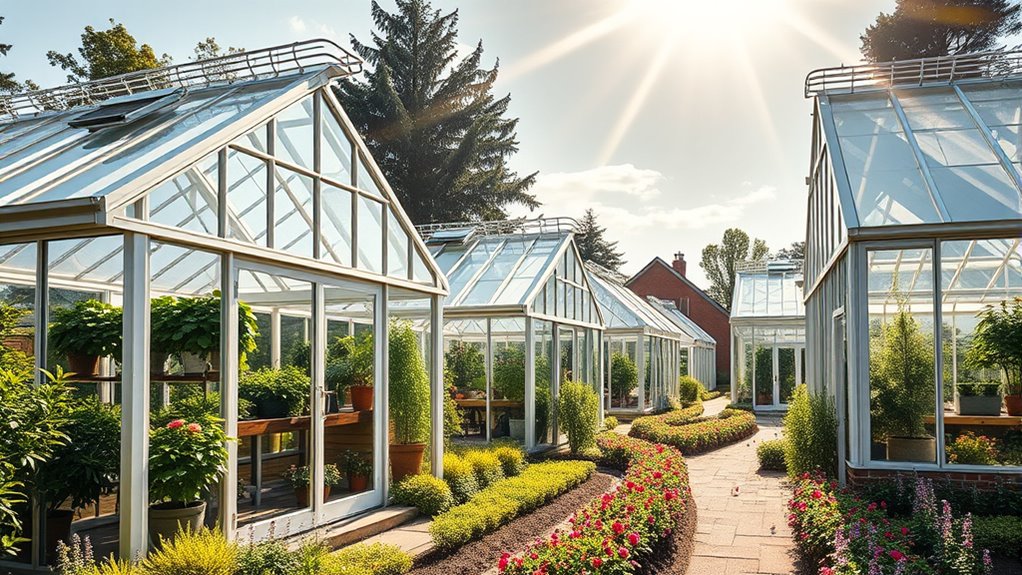
When choosing an attached greenhouse design, I always consider several key factors. Space availability, climate, and accessibility play significant roles in making the right decision. It's crucial to think about how these elements affect ventilation, light, and structural integration for a successful growing environment.
Space Availability Evaluation
Before diving into the design of your attached greenhouse, it is vital to evaluate the space available. First, I assess the total area to guarantee it accommodates both the greenhouse structure and accessible pathways for easy maintenance and harvesting. Next, I consider the orientation—positioning it on the south side of my building maximizes sunlight exposure. I also evaluate the height limitations of the adjoining structure, as this impacts design and plant selection. Additionally, I look out for potential shading from nearby trees or buildings, which could hinder light access. Finally, I determine access to utilities like water and electricity, enhancing my greenhouse's functionality and easing maintenance efforts.
Climate Considerations
After evaluating the available space, I turn my attention to climate considerations that will influence my attached greenhouse design. The local climate is crucial since temperature fluctuations, humidity levels, and seasonal changes can greatly impact plant growth. In colder areas, I look for designs that maximize sunlight exposure and retain heat, like those with polycarbonate panels. If I live in a hotter climate, I need greenhouses equipped with good ventilation and shading systems, using adjustable vents and reflective materials to prevent overheating. In regions with high winds, sturdy construction and anchoring systems are essential to withstand storms. Additionally, understanding local precipitation patterns helps me incorporate effective drainage systems to manage excess water and prevent flooding.
Accessibility and Layout
Accessibility and layout are essential factors I consider when designing my attached greenhouse, as they directly affect how efficiently I can care for my plants. I always prioritize wide pathways for easy movement and arrange plants to maximize sunlight and air circulation. Incorporating adjustable vents and thoughtful door placements not only enhances access but also promotes natural ventilation. I make certain the layout accommodates necessary equipment like shelving and pots without overcrowding, making maintenance a breeze. Planning for utilities, such as water sources and electrical outlets, is critical, too—I place them conveniently for smooth operation. Finally, I guarantee the greenhouse integrates seamlessly with my home, creating a logical flow that enhances overall accessibility.
Structural Integration
When I design an attached greenhouse, I focus on structural integration to guarantee it complements my home while maintaining its functionality. I first verify the existing foundation can support the additional weight and stress of the greenhouse. Next, I prioritize an airtight sealing between the greenhouse and my home to prevent heat loss and moisture ingress, which could compromise both structures. I also pay close attention to proper alignment and level installation to facilitate effective drainage, avoiding water pooling that can lead to structural damage. Using compatible materials for walls and roofs enhances both thermal efficiency and aesthetic cohesion. Finally, I make sure to integrate adequate ventilation for healthy airflow and humidity control between the greenhouse and my home.
Ventilation and Light
Building on the solid structural integration of an attached greenhouse, I can't overlook the importance of ventilation and light. Proper ventilation is vital; without it, I risk overheating and pest issues. I find that adjustable roof vents and side windows greatly enhance air circulation, allowing for better climate control and healthier plants. When considering light, the type of glazing matters immensely; materials like twin-wall polycarbonate panels let in up to 90% light while blocking harmful UV rays. I also pay attention to the greenhouse's orientation to maximize sunlight exposure, which optimizes growth and minimizes artificial lighting needs. Finally, a built-in gutter system helps manage rainwater, ensuring excess moisture doesn't impede ventilation or light access.
Frequently Asked Questions
What Are the Costs Associated With Building an Attached Greenhouse?
When I looked into building an attached greenhouse, I found several costs to take into account. First, there's the initial materials, which can vary widely based on size and quality. Then, I had to factor in any permits required by my local government. Don't forget labor costs if you're hiring help! Finally, I included ongoing expenses like heating, watering systems, and maintenance. It's a worthwhile investment, but planning ahead is essential.
How Much Sunlight Do Attached Greenhouses Require Daily?
When considering sunlight for attached greenhouses, I've found that most plants thrive with about six to eight hours of direct sunlight daily. It's essential to place your greenhouse in a spot that maximizes exposure, especially during the winter months. I've noticed that using reflective materials can help increase light levels, too. Remember, the right amount of sunlight can make a huge difference in the health and growth of your plants!
Can I Use an Attached Greenhouse in Cold Climates?
Did you know that nearly 30% of homes in colder climates have some form of greenhouse? I've found that using an attached greenhouse in cold climates can be incredibly effective. By utilizing proper insulation and heating systems, I can keep my plants thriving even in winter. It's essential to select the right materials and design features to retain heat, ensuring my gardening passion flourishes despite the chilly weather outside.
What Materials Are Best for Constructing an Attached Greenhouse?
When constructing an attached greenhouse, I've found that using materials like polycarbonate panels is a great choice. They're durable, provide excellent insulation, and let in plenty of light. I also prefer aluminum frames for their strength and resistance to rust. If you're looking for a more traditional feel, wood can work, but it requires maintenance. Ultimately, I'd suggest considering your local climate and budget when selecting the best materials for your project.
How Do I Maintain Optimal Humidity Levels in an Attached Greenhouse?
Maintaining ideal humidity levels in my attached greenhouse feels like trying to tame a wild beast! I've found that regularly misting the plants keeps the air moist, while using a hygrometer helps me monitor levels. I also open vents during the day to let fresh air circulate. A small water feature can work wonders too, creating a perfect balance. With these tips, I've turned my greenhouse into a humidity paradise!
Conclusion
To sum up, designing an attached greenhouse can truly elevate your gardening game, offering year-round growing potential right at your fingertips. With so many options available, which design will best suit your space and needs? Whether you opt for a DIY kit or a pre-made model, the right greenhouse can turn your gardening dreams into reality. So, let's get started and create a thriving oasis that brings joy and abundance to your home!
